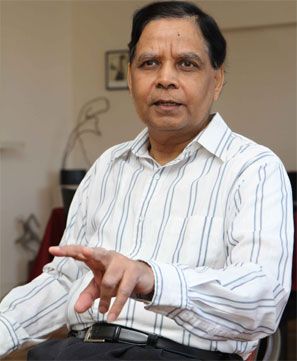 | « Back to article | Print this article |
At CII meet, NITI vice-chairman Panagariya questions India Inc’s investments in mainly capital-intensive sectors
 National Institution for Transforming India Aayog vice-chairman Arvind Panagariya on Tuesday charged companies with not investing much in labour-intensive sectors and concentrating mainly on capital-intensive ones, adding to the unemployment woes of the country.
National Institution for Transforming India Aayog vice-chairman Arvind Panagariya on Tuesday charged companies with not investing much in labour-intensive sectors and concentrating mainly on capital-intensive ones, adding to the unemployment woes of the country.
“Here is my charge to you: if I look around, none of you invest in industries, in sectors that would generate lots of employment; all of you just run away from hiring purpose,” Panagariya told a gathering of industrialists at the annual general meeting of the Confederation of Indian Industry in New Delhi on Monday.
According to Panagariya, industry wants to invest in capital-intensive sectors such as auto parts, automobiles, machinery, chemicals or areas requiring special skills such as software, telecom, pharmaceuticals.
“Every year, 12 million enter the labour force. What is your plan for the country so that more people are employed?
“We really need to think. You know the ground conditions; why you are not investing in sectors which are more labour-intensive such as food processing, electronic assembly, leather products,” he asked industrialists.
In response, CII’s outgoing president Ajay Shriram said there were valid reasons behind industry’s reluctance not to pump in money in labour-intensive sectors and that the reasons are well-known.
He cited labour problem as one of the key areas and said the Rajasthan government's move to relax labour laws might help.
Panagariya, then, asked industry why was it not forthcoming in raising these issues.
“Why an economist (Panagariya) had to come in on this issue?
"I don't hear voices from industry. You’re on the ground; you know what the constraints are.
"The sense I get from industry is that these activities are not on industry’s radar,” he said.
The NITI Aayog's vice-chairman's charge holds ground if one assesses the recent purchasing managers' index survey.
Despite expansion, the manufacturing sector did not generate additional employment for the 14 months till March this year.
“Employment stabilised during March and has showed little-change over the past 14 months; a signal that hesitation still prevails among firms,” said Pollyanna De Lima, economist at Markit Economics, which compiles PMI data.
Panagariya said labour-intensive products are what China exports big time.
To buttress his point, he said China exported clothing and accessories worth $177 billion last year, compared with India’s $17 billion.
China is set to exit these sectors; however, India is not there to fill the space, he noted.
“Why are we not on those sectors? These are the sectors from where China is poised to exit. And who is gaining? Bangladesh and Vietnam,” he said.
CARE Ratings chief economist Madan Sabnavis told Business Standard large corporates would invest in their core competent areas.
"Days of unrelated diversification are gone."
Besides, these companies would pump in money where value addition is there, he added.
For addressing the unemployment problem, Sabnavis said the policy makers should concentrate on small and medium enterprises, which could generate jobs locally.
Panagariya invited industry to work with NITI on this issue.
To a question on why the mood on the ground does not reflect optimism despite good gross domestic product numbers, Panagariya admitted that the sentiment that nothing has changed on the ground is very much there.
He said Inflation is down, current account deficit is down, fiscal deficit is under control, growth was at 7.4 per cent for the last year.
"Turnaround is there.”
"Someone says it doesn't smell like 7.4 per cent (growth in 2014-15).
In 2008-09, all the other indicators were bad, exports were declining, investments were low, and the global economy was in tatters.
Even then, growth rate was 6.7 per cent,” he added.
He noted that the new government came with a lot of promises and, hence, people ‘get impatient’.
“It’s been only 10 months (since the Modi government came to power); give it more time. Wipro chairman Azim Premji was at NITI a couple of days ago. He said for the past two months, things were moving.”
On new GDP numbers, Panagariya said the Ministry of Statistics and Programme Implementation now uses data on manufacturing from new sources, which are far more reliable than what were used before.
To a query on special economic zones from the floor, the noted economist said the legislation that was drafted during the A B Vajpayee regime was better than that was implemented by the United Progressive Alliance government.
“The original legislation that the National Democratic Alliance tried to bring in had a lot of flexibility in SEZs. The Chinese SEZs succeeded.
“One key element of the Chinese SEZs was that factor markets -- land and labour -- were very flexible.”
Image: Arvind Panagariya; Photograph: Rediff Archives